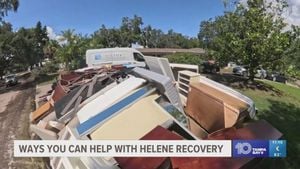On September 26, 2022, NASA made history with its Double Asteroid Redirection Test (DART) mission, successfully smashing a spacecraft the size of a vending machine straight toward Dimorphos, the small moonlet orbiting the larger asteroid Didymos. This daring impact posed the question: can humanity intervene against potential threats from space? Given the increasing studies about near-Earth objects (NEOs), the DART mission not only tested technology for planetary defense but also fueled discussions on NASA's future strategies against asteroids.
The most thrilling moment came when DART adjusted its course, steering itself onto the target. The feat of hitting Dimorphos—a rock measuring approximately 525 feet wide—was executed from nearly 7 million miles away. Analysis of the impact revealed it successfully altered the moonlet's orbit around Didymos, marking a significant leap for asteroid defense strategies and setting the stage for future missions.
Fast forward to recent months, scientists have been busy analyzing DART's staggering results. The European Space Agency's spacecraft, Hera, is slated for launch and is expected to arrive at the Didymos system by 2026. The dual missions exemplify the collaboration necessary to face global challenges posed by space hazards.
A key aim of the DART mission was to prove the kinetic impactor technique. This method, which relies on crashing spacecraft to alter the path of potentially dangerous asteroids, was successful beyond expectations. According to NASA's post-impact data, Dimorphos adjusted its orbit around Didymos by about 33 minutes, more than double the anticipated margin. This development highlights the potential effectiveness of the kinetic impactor approach to mitigate future asteroid threats.
But beyond change, the mission has sparked unparalleled interest among planetary scientists. An initial analysis of the impact sites revealed surprises about the moonlet’s material composition. Preliminary data show Dimorphos is unlike any previous asteroid observed, raising the prospect of more discoveries as we learn more about its structure and properties.
Many experts within the planetary science community have chimed in. Dr. Tom Statler, DART program scientist at NASA, remarked on the success by stating, "DART has proven we can alter the path of asteroids. This is not just science fiction; it’s science fact!" His commentary reflects the optimism surrounding our capacity to protect Earth from potential asteroids deemed hazardous.
The DART mission wasn't just about hitting things, though. It also prompted discussions about how preparedness would be handled on Earth if ever faced with imminent threats. William D. R. C. P. R. promised to examine the effectiveness of DART's findings. The confidence DART injected meant allies within the scientific community are beginning to take planetary defense quite seriously. And as the results stream through, the conversation will undoubtedly continue to shape NASA's policy and funding efforts.
Meanwhile, outreach and education tied to DART have gained attention. The mission's success encouraged numerous public engagement efforts. Educational programs and initiatives are flourishing, focusing on conveying the necessity of planetary defense and the significance of collaborations like these beyond national borders.
NASA’s ambitious goals continue to broaden with DART paving the way. Future missions planned around the success of the DART mission will examine more asteroids, refine techniques, and study NEOs extensively, with the hope to build even more advanced methods for protection. Understanding more about asteroids helps not only to forecast potential dangers but also to explore possibilities for resource utilization and exploration beyond our planet.
Experts are advising the public about the potential threats from asteroids and the importance of monitoring Space rocks orbiting our planet. They’ve built models to assess risks posed by similar NEOs and keep going back to the drawing board for improvements to asteroid tracking technology. One of NASA's main goals involves collaboration with global partners to discuss all aspects of planetary defense initiatives.
Despite its vast successes, DART’s adventure isn’t over yet. Follow-up studies will persist through the years as the data continues to be analyzed. The pivotal moment follows this initial bold strike, where the results will keep shedding light on the nature of asteroids and ways scientists can shield Earth from future impacts.
Through each step taken since the mission's conception, the DART mission exemplifies how humanity can unite for common goals. It’s not just about outsmarting space rocks but demonstrates the lengths we will go to protect our home planet from threats lying beyond the skies.



